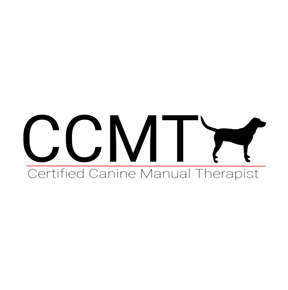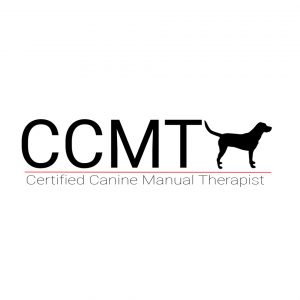CCMT Course Details
University of Tennessee Certificate Program in Canine Manual Therapy (CCMT)
CCMT I - ONLINE
Introduction to Manual Therapy – Massage and Joint Mobilizations of the Limbs in Small Animals.
Course Description:
This course is designed to teach the basic principles of manual therapy including massage/soft tissue mobilization, and joint mobilization, with an emphasis on the extremities. Participants will combine online lecture material and hands-on experience with dogs as they learn these techniques. Manual therapy concepts and evidence-based rationale for treatment selection are covered in depth. Developing goal-focused treatment plans and assessing outcomes in canine rehabilitation patients will also be covered.
Objectives: At the completion of this program, students will be able to:
- Have a working knowledge of the appendicular system, including bones, joints, articular surfaces, ligaments, muscles, and soft tissues.
- Comprehend various selected manual therapy techniques including massage/soft tissue mobilization and joint mobilization. Participants are encouraged to actively participate online and practice on their available animals.
- Discuss the indications, precautions and contraindications to various manual therapy techniques (massage/soft tissue mobilization and joint mobilization).
- Understand the basic principles of massage/soft tissue mobilization.
- Understand the basic principles of joint mobilizations with an emphasis on the extremities along with normal and abnormal end feels.
- Describe the common classifications of joint mobilization grades.
- Determine how and when to incorporate massage/soft tissue mobilization and joint mobilization into a treatment regiment
- Discuss trigger points, their etiology and management
- Discuss muscle spasms, their etiology and management
- Understand outcome measures and assessment techniques to guide the treatment progression
CCMT II - ONLINE
Joint Mobilizations of the Spine
Prerequisites: CCMT I
Course Description:
Objectives: At the completion of this program, students will be able to:
- Identify the anatomy of the spinal anatomy inclusive of palpation, individual sections, and areas of the vertebrae.
- Cervical
- Suboccipital region
- Thoracic
- Thoracic with relation to ribs
- Lumbar
- Lumbosacral region
- Pelvis
- Identify the individual components of the vertebra inclusive of the spinous process, transverse process and facet joints.
- Identify the spinous and transverse processes of the available vertebrae independently
- Understand the functional anatomy of the spine as it relates to movement
- Understand the motions of flexion, extension, side flexion and rotation at each level of the spine
- Understand the individual movement of the spinal regions independently and how it relates to the appendicular skeleton
- Understand the principles of Maitland mobilization as it applies to the spinal movement with regard to grades I to IV
- Learn to assess end feel for each level of the spine and apply graded movements appropriately to manage pain and stiffness at each individual level of the spine
CCMT III - LIVE LAB
(1 day) – Joint Mobilization and Massage Skills check-offs are required to pass the course.
Prerequisites: CCMT I
Course Description:
This course is designed to teach the basic principles of manual therapy including massage/soft tissue mobilization, and joint mobilization, with an emphasis on the extremities. Participants will combine online lecture material and hands-on experience with dogs as they learn these techniques. Manual therapy concepts and evidence-based rationale for treatment selection are covered in depth. Developing goal-focused treatment plans and assessing outcomes in canine rehabilitation patients will also be covered.
Objectives: At the completion of this program, students will be able to:
- Accurately palpate selected boney segments and landmarks, muscles, ligaments, and other soft tissues.
- Describe various selected manual therapy techniques including massage/soft tissue mobilization and joint mobilization
- Discuss the precautions and contraindications for various manual therapy techniques (massage/soft tissue mobilization and joint mobilization)
- Demonstrate on a patient selected range of motion exercises including: cervical motion, thoracic motion, lumbar motion, digit motion, carpal motion, elbow motion, shoulder motion, hock motion, stifle motion, and hip motion.
- Demonstrate on a patient selected massage/soft tissue mobilizations including supraspinatus/biceps, scapular entrapment, iliopsoas (diagnostic and therapeutic), gracilis and hamstring muscle mobilization.
- Demonstrate on a patient selected joint mobilizations of the shoulder, elbow, carpus, metacarpals, digits, hip, stifle, tarsus, metatarsals, and digits to include patient and therapist positioning, hand placement, and grade/direction of force applied.
- Discuss outcome measures and assessment techniques to guide the treatment progression
- Integrate manual therapy into the overall treatment program
CCMT IV - LIVE LAB
(2 days) – Joint Mobilizations of the Spine – Mulligan Concept and Incorporating a Multimodal Approach. Skills check-offs will be required to pass the course.
Prerequisites: CCMT I, II and III
Course Description:
Objectives: At the completion of this program, students will be able to:
- Accurately palpate selected boney segments and landmarks, muscles, ligaments, and other soft tissues.
- Describe various selected manual therapy techniques including massage/soft tissue mobilization and joint mobilization
- Discuss the precautions and contraindications for various manual therapy techniques (massage/soft tissue mobilization and joint mobilization)
- Demonstrate on a patient selected range of motion exercises including: cervical motion, thoracic motion, lumbar motion, digit motion, carpal motion, elbow motion, shoulder motion, hock motion, stifle motion, and hip motion.
- Demonstrate on a patient selected joint mobilizations of the shoulder, elbow, carpus, metacarpals, digits, hip, stifle, tarsus, metatarsals, and digits
- Demonstrate on a patient selected joint mobilizations of the cervical, thoracic, lumbar spine, and SIJ including Maitland’s grade I through IV mobilizations
- Demonstrate on a patient a NAG and a SNAG via Mulligan on the cervical and lumbar spine
- Discuss outcome measures and assessment techniques to guide the treatment progression
- Integrate manual therapy into the overall treatment program
CCMT V - ONLINE
Case Studies
Prerequisites: Successful Completion of CCMT courses I-IV
Case Study Requirements:
Students will upload video case studies demonstrating proficiency and knowledge of manual therapy in rehabilitation cases. Three cases will be submitted for review. After successful review of these cases by faculty, students will qualify for CCMT VI: Online Final Exam and Video Case Studies.
Objectives: At the completion of this program, students will submit three cases demonstrating:
- Accurate palpation of selected boney segments and landmarks, muscles, ligaments, and other soft tissues.
- Various selected manual therapy techniques including massage/soft tissue mobilizations and joint mobilizations.
- Understanding of the indications, precautions and contraindications to various manual therapy techniques (massage/soft tissue mobilization and joint mobilization)
- Selected range of motion exercises including: cervical motion, thoracic motion, lumbar motion, digit motion, carpal motion, elbow motion, shoulder motion, hock motion, stifle motion, and hip motion.
- Selected massage/soft tissue mobilizations supraspinatus/biceps, scapular entrapment, iliopsoas (diagnostic and therapeutic), gracilis and hamstring muscle mobilization.
- Selected joint mobilizations of the shoulder, elbow, carpus, metacarpals, digits, hip, stifle, tarsus, metatarsals, and digits
- Selected joint mobilizations of the cervical, thoracic, lumbar spine, and SIJ including Maitland’s grade I through IV mobilizations
- NAGs and SNAGs via Mulligan on the cervical and lumbar spine
- Outcome measures and assessment techniques to guide the treatment progression
CCMT VI - ONLINE
Timed written exam including video cases.
Prerequisites: Successful Completion of CCMT courses I-V
Objectives: At the completion of this program, students will be able to:
- Describe normal and abnormal canine peripheral joint and spinal joint biomechanics
- Accurately palpation bony landmarks, major muscles.
- Describe and assess end-feels of the peripheral joints
- Describe the differences between manual therapy and manual mobilization
- Establish a baseline for normal canine joint motion as it relates to movement.
- Establish the knowledge to assess a dog from a biomechanical concept to establish losses of movement as it applies to function
- Determine normal vs. abnormal movement in individual joints
- Determine mechanical losses and gains of motion as they relate to movement.
- Demonstrate proficient passive range of motion of the peripheral and spinal joints on a dog
- Explain the principles of joint mobilization on the dog inclusive of indications, contraindications, and precautions
- Understand the safety and methods to appropriately position and work with dogs to successfully perform manual therapy and mobilization
- Describe the principles and applications of mobilization applied to dogs as set forth by Geoffrey Maitland



